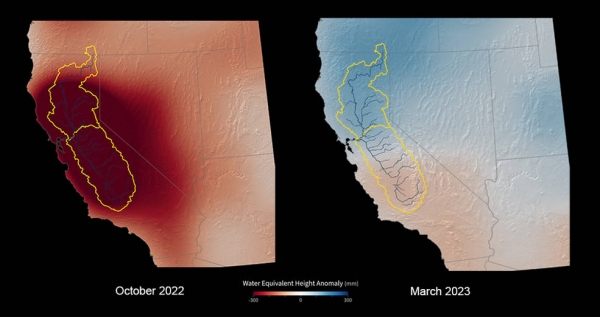Early data shows the greatest net gain of water over the winter in nearly 22 years, but the state’s groundwater levels still suffer from the effects of years of drought.
After years of intense drought and diminishing groundwater, California just saw its greatest year-over-year water gains in two decades, according to data from the GRACE-FO (Gravity Recovery and Climate Experiment Follow-On) satellite mission, a partnership between NASA and the German Research Centre for Geosciences (GFZ). This past winter’s bonanza of atmospheric rivers alleviated some of the water deficit that the state incurred during periods of drought over the last 10 years, which included the three driest years on record in California.
Think of the state’s Central Valley region (outlined in yellow, above) as a giant swimming pool: GRACE-FO measurements include all the water contained in the lakes, rivers, soil, snowpack, and underground aquifers within that region. Between October 2022 and March 2023, storms provided enough water to raise the amount of water within the “swimming pool” by about 20 inches (about 500 millimeters). That’s about twice as much as the average winter water gain since satellite-based water storage measurements began in 2002 with the first GRACE mission.
Read more at NASA
Image: Thanks to a wet winter, California saw tremendous gains in the amount of water in the San Joaquin, Sacramento, and Tulare river basins (outlined in yellow) from October 2022 to March 2023, GRACE-FO data shows. The measurement includes water in lakes, rivers, reservoirs, snowpack, and groundwater aquifers. (Credits: NASA’s Scientific Visualization Studio)


